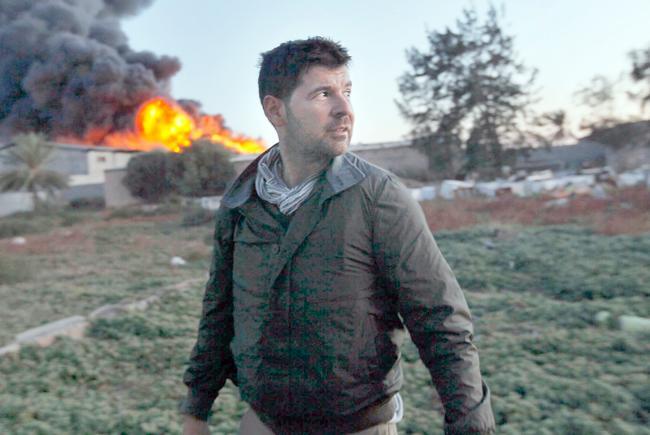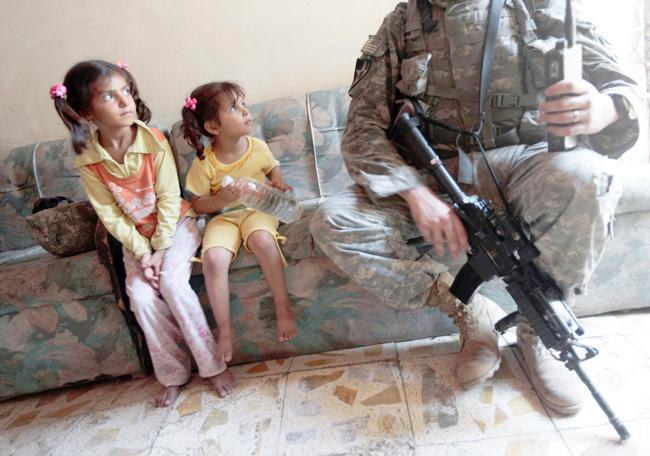Chris Hondros did whatever it took to get what he considered the best image. He cheated death countless times to capture the pictures that he thought would impact the world.
Hondros , a photojournalist with Getty Images and N.C . State alum, didn’t shy from risk while on assignment. One photo in the midst of the Liberian civil war got him nominated for a Pulitzer Prize. From Sierra Leone to Afghanistan, his work made it on the covers of The Economist and Newsweek and on the front pages of The New York Times and the Washington Post.
Hondros presented his humanity and conviction for people in each assignment, up until his last.
“Libya?”
Greg Campbell, a journalist and friend of Hondros for 26 years, received a text message from him on March 29, 2011.
“Libya?” Hondros asked in a text message. “I’m thinking this weekend, seriously.”
Campbell said Hondros didn’t need to provide any further the context for the question. Campbell worked with Hondros in Sierra Leone, where both documented the decade-long civil war-Campbell with words, Hondros with images. When Hondros brought up Libya, Campbell knew what he was up to.
“I had turned down all other invitations to go to places that were much less dangerous at the time, but I don’t know why, it just seemed like good timing,” Campbell said. “Something was just compelling me to make sure I was there.”
Campbell called USA Today, asked the editor for an assignment, and without much consultation with his wife, he flew to North Africa to meet Hondros to cross into Libya to document the civil war that arose from the Arab Spring, between rebel troops and dictator Moammar Gadhafi.
Campbell and Hondros spent a week together in Misrata, an anti-Gadhafi stronghold in the beginning of the 2011 conflict. Campbell left Libya with a feeling that Hondros would make it out of Libya, like he made it out of the other conflicts he covered, unscathed.
Campbell said Hondros had an expression: “Nothing happens until it happens.” Campbell returned from his travels in North Africa the day before he found out on Twitter that it happened.
April 20, 2011, Hondros and photojournalist Tim Hetherington, director of Restrepo, died from an explosion from a rocket launcher.
“It was complete disbelief,” Campbell said. “It was complete and utter shock. I considered him to be the guy who would always come back … Having been there just the week before, I was aware of how careful he was.”
A hunger for adventure, an eye for emotion
Hondros wanted to see the news and not just read about it, Campbell said. For much of the Hondros’ career, he was dedicated to the task of conflict photojournalism, which took him to places like Kosovo, Sierra Leone, Liberia, Iraq, Egypt and Libya. By being in the path of danger, Hondros was able to capture and share the humanity among the stories of war and pain.
His work caught the eye of Christina Piaia, a former photo editor for the Associated Press, when she first came across Hondros’s images. She would soon become his fiancee.
“He really always took into account the human experiences in the places that he was going,” Piaia said. “So whether he was at a local news story or abroad in a conflict, he always looked to the people involved and wanted to record and document their stories.”
Piaia wasn’t the only one who recognized that Hondros’ photography not only demonstrated great skill, but also an eye for the thread of common humanity running through the experiences of war and suffering.
According to Paul Woolverton, an alum and reporter for the Fayetteville Observer who studied and worked with Hondros, the skill that allowed Hondros to capture deep emotion was something that he developed at a young age.
“[His skill] was a combination of things,” Campbell said. “It was experience; he had been to dangerous places before, so he knew where things were going to happen. He managed to put himself in the right place at the right time. Another big component was patience.”
Chris would wait days on end to find the exact image he needed, according to Campbell.
What drove Hondros to cover conflicts was a heart for telling a story that was difficult to tell and difficult for some to hear, according to Alex Miller, associate vice chancellor for student affairs who met Hondros during his visits to campus in 2004 and 2010.
“He could have gone out and photographed beautiful beaches in Hawaii or the Bahamas, but those were not the stories that appealed to him, and the reason they were not is because [he] was a guy that really understood how important it was to make sure that the tough stories got told honestly,” Miller said.
Hondros’ friends said his curiosity and vigor was something that were always dominant parts of his personality.
“That’s just the way Chris was,” Campbell said. “He cared about strangers, his friends. He was literally the best friend anybody could have. He was caring and compassionate, and the fact that that quality bled into the subjects of his photos, that doesn’t surprise anybody who knew him very well.”
According to Piaia, this compassion allowed him to capture things that others couldn’t.
“A lot of his pictures show this shared sense of humanity among things, and it connects you in a more visceral way than other images, and that was very much in tune with his personality and his sensibilities,” Piaia said. “I think that he just happened to be a very kind and generous person, and I think he really understood a lot of the ideas of human emotion.”
Hondros showed this generosity in many ways, by sponsoring a former Liberian militia commander to return to school in one case, or by renting out restaurants in New York City to host “infamous” parties for his friends, according to Piaia.
“Chris’ philosophy on life was just to live it to the fullest,” Campbell said.
A legacy through generosity and pictures
Hondros recognized the power of an education. Joseph Duo, a former militia commander in Liberia, was the subject of the photo that received a Pulitzer Prize nomination. Once the fighting subsided in Liberia, Hondros returned to the West African nation to see if he could find Duo again.
“[Hondros] was just a good guy,” Woolverton said. “He went back to find [the rebel soldier] after the war was over to try and help him. All he [Duo] knew was war. He was a rebel soldier, and then the war ended, and apparently he was having difficulties.”
Hondros spent the last day of his last trip to Liberia looking for the best school for Duo, according to Campbell. Duo is now a high school graduate.
“Joseph would send his report cards back to Chris,” Campbell said. “Chris became his mentor or his sponsor from a distance … Chris didn’t publicize this. He wrote about it once for an industry journal, but he wasn’t the kind of person to brag about that kind of thing.”
Mentoring and teaching new generations was always something that Hondros was passionate about. And now his friends and family are continuing his legacy.
On April 6, the Artspace art gallery in downtown Raleigh hosted an exhibition commemorating Hondros’ life and work.
The exhibit covers more than a decade’s worth of struggle from across the world. The night before the opening to the public, Getty Images flew its senior staff to the exhibit for a private ceremony. The opening night brought hundreds into the gallery full of photos, of Hondros’ best work.
“For me, it is overwhelming … I thought the exhibit was very well put together,” Inge Hondros, Chris’ mother, said.
Of the gallery’s images that covered Hondros’s career, a handful were from his last assignment. Though Hondros didn’t make it back to convey more stories, the subjects of his images are still telling theirs.
“[From this exhibit] I want people to come to appreciate how difficult the job is, first of all, and how important the job is too, in the understanding of the world,” Campbell said. “I hope that people don’t just take away not just how wonderful of a person and professional photographer Chris was, but how important the work he did was.”
Two Iraqi girls look at Staff Sgt. Nick Gibson of the 2nd Battalion, 12th Infantry Regiment of the 2nd Infantry Division June 21, 2007 while canvassing the tense Dora neighborhood of Baghdad, Iraq. US soldiers canvas their area almost every day, attempting to get to know the residents and find insurgents. Photo by Chris Hondros via Getty Images









